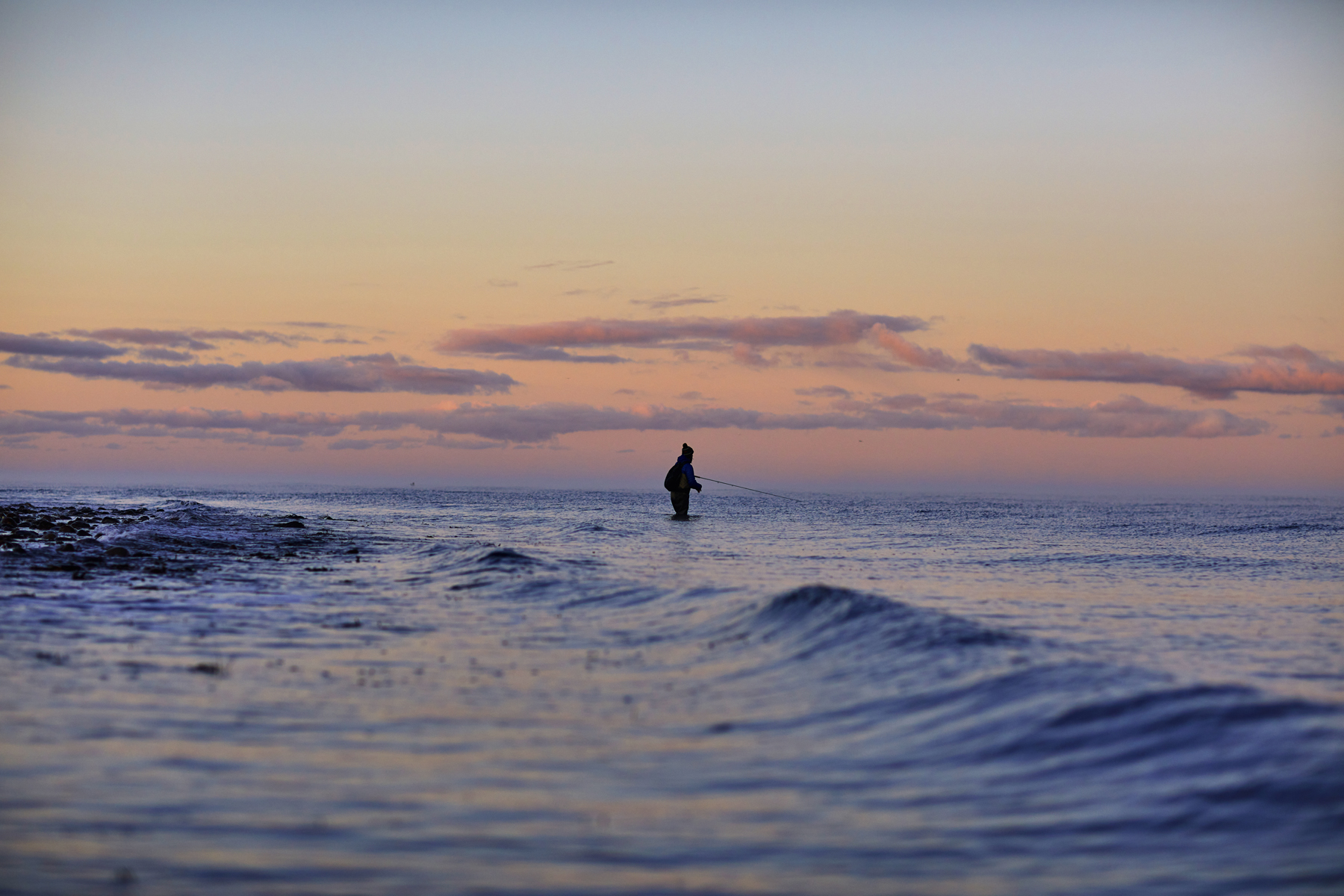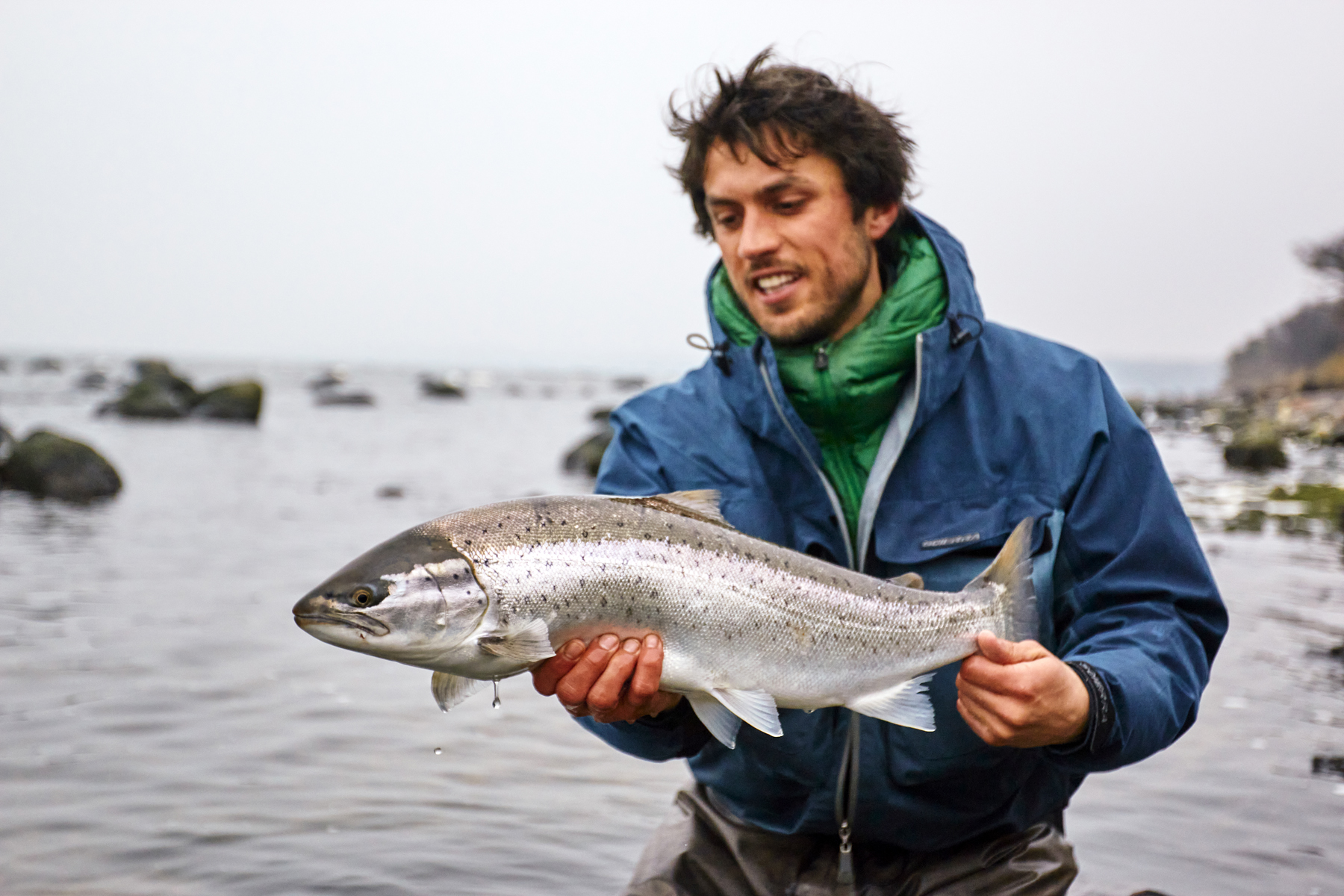
7 minute read
Macro Seatrout on Micro Flies: A Flea Cirkus
Macro Seatrout on Micro Flies: A FLEA CIRKUS
When coastal conditions are challenging, Tobias Park pulls out the very small fleas from his fly box. The result is surprising, because while the flies are remarkably small, the average weight of the seatrout he catches moves in the opposite direction.
By PETER LYNGBY // Images by Sarah Rønholt and Tobias Park

Can you really tie all your flies without being a fly tyer?
You certainly can, according to Tobias Park. Although he finds it distasteful to fish with flies that he hasn’t tied himself, he hates tying flies and would much rather spend his time fishing.
One of the flies Tobias will soon find himself forced to tie more of is his variant of the North Zealand Bladlusaborten, which Jesper Fohrmann tied the first samples of in the early 1990s.
Tobias’ fly box looks terribly empty when we meet for a chat about big trout and small flies. Tobias Park first became acquainted with Bladlusaborten when he was just five years old, fishing for seatrout on the coast with his father.

A fixture for over twenty years
– “It was my father, Mike Park, who took me on my first coastal fishing trips.
I wasn’t old enough to handle a fly rod yet, but I clearly remember how my father meticulously attached the small fly to the end of what seemed to me like an infinitely long and thin leader, tied to my bubble float. The Aborten was a success from the start, and I thought my father had invented a fantastic fly. Even though the pattern was actually Jesper’s. We caught many seatrout on the Bladlusaborten even back then, and since then, the pattern and various variants have never left my coastal fly box,” begins Tobias Park.
– “For me, Bladlusaborten is the fly for those frustratingly frequent and highly challenging days when the trout simply aren’t interested in anything. The impossible days with impossible conditions. Completely calm and clear water, and so on. I prefer to fish with larger, more common coastal flies when I find that the conditions are “right”, and I will always prefer days with a bit of wind and some colour in the water. Nevertheless, I am repeatedly amazed at the fish I encounter on these socalled impossible days.

There is another technique that I brought back from Scotland, where I worked as a ghillie on the Outer Hebrides for a while. On the lakes up there, it was a well-known technique to fish with two flies. But not the way it is common on the Danish coasts with a small fly followed by a big one. No, in fact the opposite. That’s why I often fish flies like the Aborten as the trailing fly behind a larger, more buoyant fly. Typically, a classic muddler like the Muddler Minnow in size 6 or 8. The muddler fly streaks through the surface and attracts attention, but the trout usually prefers the small trailing fly.
I really can’t stand fishing with two flies, and it’s not without risk with an extra hook when you hook a big fish in shallow water. But the technique is just incredibly effective. Typically, I attach the muddler to a strong 0.30 mm dropper. I attach the micro fly just about thirty to fifty centimetres behind,” Tobias explains.

Double instead of treble
The calm conditions and delicate small flies naturally call for the use of very light fly gear, but due to the possibility of catching a big seatrout, Tobias always fishes with the strongest fly gear he considers possible on the day. – “On the coast, I almost always fish with fly rods between class 5 and 7. I almost always fish the various flea flies on a floating line, but if I’m fishing more thoroughly over slightly deeper water, I might use a hover or intermediate line.
I tie my own leaders. Partly to get them exactly the way I want them, partly because I can’t bring myself to buy expensive pre-made leaders. I can tie a whole swarm of leaders for the same price as a single factory-made leader. I use nylon leaders of 10-12 feet, adjusted according to the conditions. That means with a longer butt section for rough weather or a longer tip for delicate presentations. I don’t think the super long leaders that some people advocate are necessary for coastal fishing. My leaders typically end in a 0.23-26 mm tip, but on the 5-weight rod, I sometimes go down to 0.18 mm.

As I said, I use flea flies in different sizes, and I usually tie the larger ones on single hooks, like most sand flea imitations. I’ve also tied some of the small ones on slightly stronger single hooks for a friend who needed them for fishing with a bombarda float. But they just don’t perform as well as the double hooks.
When I fish for salmon, I often use very small flies, like Francis on treble hooks down to size 14-16. These also work on the coast, but the double hooks hold much better balance. A size 12 double hook is the largest I use. I use them down to sizes that can fit inside the hook gap of that fly. In other words, really small flies. Unfortunately, you now have to search far and wide to find such small double hooks,” Tobias laments.

Tying tips
Tobias has a few tips worth noting when you tie his variant of the Bladlusaborten. The original fly had hackle stems as tails. On the hackles, a few fibers are left at the tips to form a small triangle, which helps to support the fly. However, for the larger versions, Tobias has switched to boar bristles, which naturally serve the same function.
– “For the body hackle, I prefer to use thin feathers in dry fly quality, where I strip one side of the fibers. That way, the fly doesn’t get overdressed. The orange version is a good starting point, but I’m not too particular about the shades, and I encourage you to experiment with the tones of both the hackle and dubbing,” concludes Tobias.

Materials:
Hook: Ahrex HR428 str. 12 (Gold or Black Nickel)
Tying Thread: Black, orange or red
Tail: Orange Wild Boar
Body: Orange Seal Dubbing or similar
Rib: 0,20 – 0,25 mm nylon
Body Hackle: Grizzly

Mount the tying thread onto the hook.

Tie in two boar bristles so they form a V pointing backward.

Tie in the nylon ribbing and then the tip of the hackle at the back. Dub a full body of seal fur.

Dub a full body of seal fur.

Wind the hackle forward over the dubbing. About 3-4 turns are suitable.

Finally, wind the nylon ribbing carefully through the hackle, and finish the fly.











